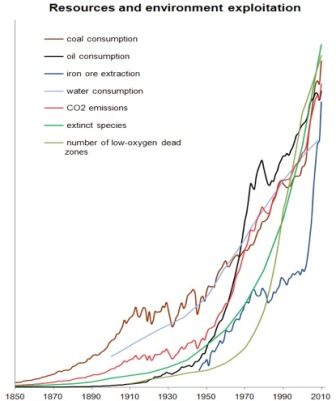The topic of population growth is often omitted from any debate regarding environmental impact in all academic circles ranging from classical to heterodox. While it is undeniable that the global population is increasing and will continue to increase for some time, no serious address towards the seemingly obvious relationship between population growth and environmental degradation is directly discussed. While historical precedents exist for active population control, they are often seen as serving an ulterior motive and the topic of population control is generally treated as a taboo subject. It seems clear that the issue must be addressed, yet perhaps the solution does not require the discussion of population at all. This blog post will dive deeper into the population discussion and attempt to give some direction for the Degrowth community as to how to face this phenomena moving forward.
One of the most well known and often cited relationships with regards to human activity and its environmental impact is illustrated in the simple and digestible equation I (ecological impact) = P (Population) * A (Affluence) * T (Technology). A significant amount of work has been conducted by the academic community in dissecting various aspects of this equation in order to offer sustainable pathways that lead to a brighter future for next generations.
However, the population indicator (P) is often skipped over and treated as a taboo among policy making and academic circles alike. Yet, it seems rational to assume that the root of the struggle lies in consumption patterns and tendencies on a microeconomic level. As consumption on a microeconomic level can be assessed when looking at per capita statistics, it is naturally implied that a decrease in consumption could be offset by an increase in population, rendering attempts to curb consumption null.
Population growth statistics
Currently, the global population is on track to reach 9.8 billion people by 2050, and 11.2 billion people in 2100. When breaking up the world into the three categories of High, Middle and Low income as classified by the World Bank, population growth (annual %) is 0.6%, 1.1% and 2.6% respectively for the year 2017. High and Middle income countries have seen a steady decline in population growth since the year 1968, with Low income countries experiencing no change over the same period of time.
Forecasting into the future, it is expected that the decline in population growth rate will continue, with some estimates indicating in 2099 population growth rates will reach -0.01%, 0.11% and 0.57% for developed regions, less developed regions and LDC’s respectively.
The general assessment is that while the absolute number of humans will increase through to 2100, the population growth rate will continue to decline over time. In traditional Economics, this relationship is to be expected as countries move away from agrarian dominated economies towards manufacturing and service industries and become wealthier in the process. But even though population growth rates are declining across the world, the discussion of population as a variable in the equation introduced in the beginning of this post has largely been left out of the discussion by both policymakers and academics alike. The most exposure the public receives to population-based conflicts on natural resources comes in the form of science-fiction and fantasy literature and movies, thus allowing the average person to simply write off the problem the same way they would write off a possible alien invasion.
Population, what to do?
An inverse relationship begins to appear between population growth and quality of life; the more people there are on the planet, naturally the lower options for a good life exist. This relationship is especially true when considering the desire from the degrowth community to contract GDP growth in order to dramatically reduce our ecological footprint to sustainable levels. In order to hope to contract GDP growth through a change either in basic consumption behaviors or a shift away from profit-driven capitalism, one must first duel with the idea of dramatically decreasing the global population.
Population has often been treated as a taboo, an elephant in the room, an undesirable topic to discuss for a variety of reasons. Some outspoken Degrowth members do not wish to interfere with women’s reproductive rights and they wish to build upon the idea of eco-feminism. Others do not want to allow extreme right wing, anti-immigration and/or xenophobic fringe communities a seat at the table as these groups have historically been associated with population control discussions.
The existing literature has identified several potential reasons as to why the population debate has died. While this post won’t go into detail on those reasons, some of them include the financial and economic concern of an ageing society, the fear that some ‘less desirable’ groups will be unfairly targeted with population control measures, and the skepticism that population growth is even a problem in the first place.
The examples listed above capture a significant portion of the resistance to address population control measures, and gives some insight into the reluctance of both governmental and global organizations to address the issue directly. They also lend credibility to the notion that population control has historically been closely linked with harmful forces such as racism, xenophobia and eugenics.
Another way forward?
Perhaps there is a different approach that, while including population in the mix, reduces emissions substantially
without discussing population control measures. A report released by Oxfam charts the percentage of CO2 emissions by world and population and highlights a very significant fact; t
he world’s poorest 50% are only responsible for roughly 10% of total global lifestyle consumption emissions, while the worlds richest 10% are responsible for just shy of 50% of total lifestyle consumption emissions. The general notion of this finding has been well known for some time; the richer you are, generally the more you consume and therefore the more carbon emissions you are personally responsible for.
Thus, in order to circumvent the potentially explosive debate regarding direct population control measures, the conversation could be refocused around the reduction of consumption by the wealthiest percentage of the global population.
While global population growth remains positive, the degrowth community should continue to champion aggressive reductions in consumption patterns rather than shift its attention to the political black hole of population control measures. While a shift in consumption patterns requires a societal change, this change will have beneficial short term gains and more importantly government action against consumption patterns can be less intrusive in the daily lives of individuals as compared to actions restricting procreation. While population growth remains an issue, more effective tools exist that, at least in the short term, do a great deal in combating the human populations global footprint.


